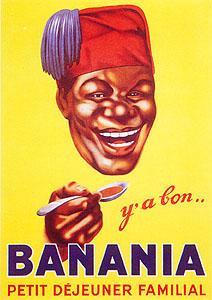A french journalist Pierre Lardet discovered a cocoa based recipe made of cocoa, cereals, honey, sugar and banana flour during his visit in Lake Managua, Nicaragua in 1909. He brought this recipe home in Paris and introduced a new drink called Banania in.
On of Lardet strategies to promote his cocoa based drink is to integrates his drink with the colonial troops around World War I. Banania used the tagline of pour nos soldats la nourriture abondante qui se conserve sous le moindre volume possible (‘for our soldiers: the abundant food which keeps, using the least possible space’ by promoting it thorough an image of a Senegalese man enjoying his Banania drink. The mixture of color yellow (to indicates the banana ingredient), red, blue and white (from the Senegalese man uniform and also to indicates France as the origin country of the product) is used as the highlights of the advertising of banania cocoa drink.The tagline which is originally ‘Ya’bon’ (means it’s good) is supposedly derived from a pidgin french language spoken between the soldier (which in fact it is an invention), later transformed to the slogan and the character became inseparable as the expression was coined: l’ami y’a bon (“the y’a bon buddy”).
In 1970s and 1980s, Banania sponsored the Yellow Yersey for Tour de France to continue its promotion around France and gained its name internationally. The advertising promotion of Banania began to attracts attention from the local who their origin is from the black ancestors and also others who are concerned on the impact of the pop culture advertising to the image of France. As much as it has caused several conflicts with its ‘manipulative image’ of a black guy in its product branding, banania became the cultural icon in France. Even though the form of the character of Banania have evolved through years, its name and its original advertising continue as one of the popular culture around the world. Banania posters and reproductions of the packaging, tin-plates sign of the pre-war advertising continue as a demand on the current market.

Banania logo in 1930 (image from wikipedia)
